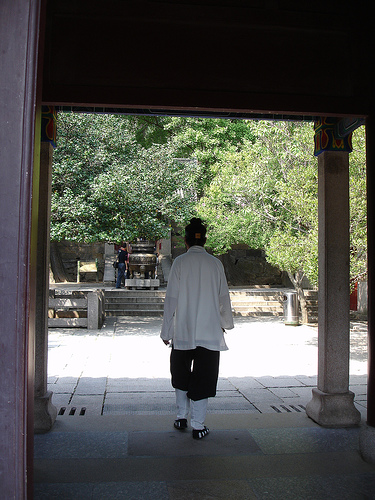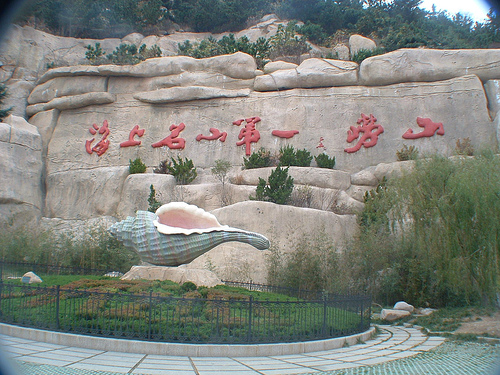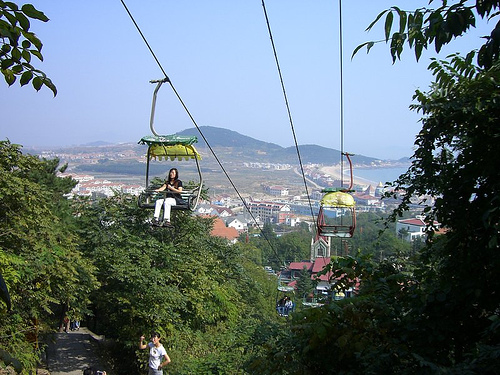With its highest peak rising 1,133 meters above sea level, Mt. Laoshan is situated on the southeastern Shangdong peninsula. Facing the Yellow Sea, it is one of China's major scenic resorts and has long held the reputation as the No. 1 Famous Mountain on the Sea.
The entire mountain covers 446 square kilometers and has 218 places of interest, big and small.
It is a famous Taoist mountain boasting both mountainous and coastal scenery. Among all the well-known mountains across China, it is the only one on the coast. It has a coastline of 87.3 kilometers, with 13 bays and 18 islets nearby. Rambling along a stone-planked path on the mountainside, you will be touched by both huge tides on the sea and lush pine trees and misshaped rocks on the shore, and will thus feel broad-minded and relaxed. Legend has it that some 2,500 years ago, the first emperor of the Qin Dynasty (221-206BC) came here hoping to meet immortals, and later so did Emperor Wudi of the Han Dynasty (206 BC-220 AD), giving a mysterious air to Mt. Laoshan.
At the peak of Taoism, there were nine palaces, eight Taoist temples, and 72 nunneries that housed nearly 1,000 Taoist priests and nuns on the mountain. At present, the Taiqing Palace is the largest and oldest among the preserved Taoist establishments. First built in the early Northern Song Dynasty (960-1127), the palace has a history of nearly 1,000 years and features a simple architectural style. It is surrounded by countless scenic spots and is the center of the entire tourist area.
The Western Memorial Temple for Guan Yu and Yue Fei in the Sanqing Palace is a must for visitors to Mt. Laoshan, because it was formerly a residence of Pu Songling, a renowned novelist of the Qing Dynasty (1644-1911). Many stories in his novel Strange Tales from a Lonely Studio have Mt. Laoshan as the backdrop. In front of the Sanguan Hall there is a 700-year-old camellia shrub. Among the largest camellias in the world, it is 8.5 meters tall, and its trunk is 1.78 meters around. When blooming in midwinter, its flowers look like a layer of deep-red snow covering its green leaves. There was originally a white peony that reached the hall's eaves. Pu Songling dwelled here during his late years, with the camellia and the peony as his neighbors. The two flowers turned into two pretty women who fell in love with a young literati in his fairy tale Xiangyu.
Among the places of interest near the Taiqing Palace are the Elm Shaped Like a Dragon's Head and the Stone Carvings on the Cliff.
Mt. Laoshan is known for its oddly shaped rocks, ancient trees, and crystal-clear springs. Among the most famous springs are the Tianyi Spring on the mountaintop, the Shenshui (Immortal Water) Spring in the Taiqing Palace, and the Shengshuiyang (Ocean of Holy Water) Spring in the Shangqing Palace. People say the mineral water produced here can cure chronic diseases.
Travel tips
Mt. Laoshan is a tourist attraction on the outskirts of Qingdao, 30 kilometers away from the city proper. The Liuting Airport is 34 kilometers north of the mountain. Before visiting Mt. Laoshan, you should visit Qingdao, a picturesque coastal city that boasts many scenic spots, such as the Plank Bridge, the Lu Xun Park, the Aquarium, the Zhongshan Park, and the Bathing Beach. The city is 800 kilometers away from Beijing, and it takes about 13 hours from Beijing to Qingdao by train. You can take tourist buses from Qingdao to Mt. Laoshan for one-day, two-day, or three-day trips.
There are also public bus routes going directly to different points of interest. There is Bus 104 from Taidong to Liuqing River, as well as Bus 110 from Taidong to Beijiushui, Bus 301 from Tuandao to Shazikou, Bus 304 from the Ferry Port to Yakou, Bus 311 from Tuandao to Beijiushui, Bus 312 from Tuandao to Yangkou, Bus 106 from Licun to Yakou, Bus 107 from Licun to Beijiushui, Bus 112 from Licun to Daglaoguan, Bus 113 from Licun to Liuqing River, and others.
At the Mt. Laoshan scenic resort, there are more than 40 hotels and restaurants of various quality, including the Jinshan Entertainment City and the Dongli Hotel in the Taiqing Scenic Area, the Yulong Hotel and the Dongxing Hotel in the Liuqing Scenic Area, the Haier Hill Village and the Donghai Pearl Hotel in the Yangkou Scenic Area, and Huaxing Hill Village and the Qingdao Daily Training Center in the Beijiushui Scenic Area.
Ticket Price: 70 yuan; 15 yuan to the Taiqing Palace; and 10 yuan each to the Shangqing Palace, the Mingxia Cave, and the Taiping Palace.
(China.org.cn)








